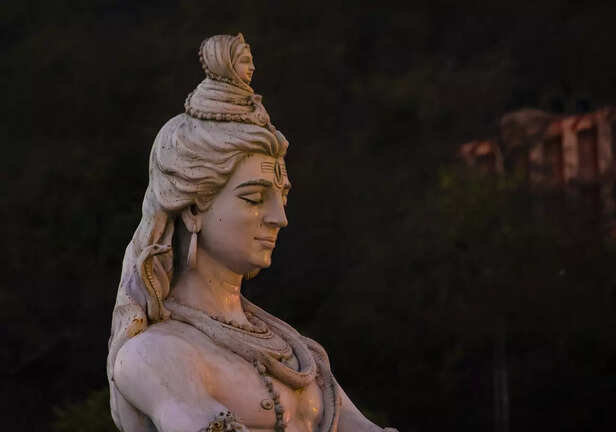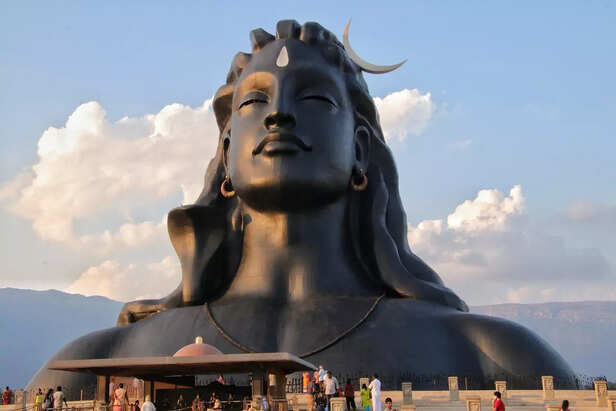Why Did Lord Shiva Drink the Poison of Doom? A Timeless Life Lesson
Mohd Naushad | Feb 11, 2025, 18:34 IST
( Image credit : Timeslife )
During the Samudra Manthan (churning of the ocean), a deadly poison called Halahala emerged, threatening to destroy the universe. Lord Shiva selflessly drank it, holding it in his throat, earning the name Neelkanth (Blue-Throated One). This act symbolizes resilience, sacrifice, and emotional endurance—lessons deeply relevant today. Just as Shiva contained the poison without letting it consume him, we, too, must face life’s toxicity—stress, negativity, and hardships—without letting them overpower us. His story inspires strength, balance, and selfless leadership in modern life.
Mythology itself is replete with subliminal meanings and symbols that convey timeless concepts. One of the many stories in Hindu mythology is the Samudra Manthan, in which the Lord Shiva destroys the poison during the ocean's churning. It is a very magnificent and prestigious story. It emphasizes a cosmic path of sacrifice and responsibility in preserving equilibrium, making it more than merely a tale of supernatural activity. However, why did the ultimate ascetic, Shiva, take on the task of ingesting poison? What are some other, lesser-known facets of this story that add to its intrigue? Now, let's learn more about the mystique that lies behind the fabled performance.

The Samudra Manthan, or the churning of the ocean, is one of the most important events in Hindu mythology. Their scriptures speak of the Devas and Asuras warring against each other for supremacy. Eventually, in their quest for immortality, they compromised to churn the cosmic ocean (Ksheer Sagar) and draw amrita from within. The two sides would continue this rigorous process using the celestial serpent Vasuki as a rope and Mount Mandara itself as the churning rod. Various extraordinary and ecstatic objects revealed themselves - precious gems, celestial beings, divine animals, and the very goddess Lakshmi herself emerged after churning. Yet also, something terrifying and horrible also raised a fear-a deadly poison that could destroy all lives-Halahala.

Halahala poison was not like any other poison. A single drop of it would destroy creation. From the very moment it appeared, its fumes spread out in all directions toward the heavens asphyxiating the gods, the demons, and every living being. The celestial beings panicked at the thought that everything they did could go in vain because the poison could not be contained. The Devas then went to Lord Brahma, the creator, to seek his help. But even Brahma, despite being very wise, had no solutions to this. They again went to Lord Vishnu, the preserver, who also admitted to having limited powers against such a potent force. There was only one being capable of carrying such a burden, Lord Shiva, the supreme destroyer and protector.

Shiva had no qualms in accepting the call from the gods, he was conscious that this poison could spell disaster for the universe if left unchecked. He, therefore, thought to save the world by ingesting the poison. With that thought, Shiva took the Halahala in his palm and drank it like water. When the poison touched his throat, it burned like fire. His throat became blue while the pain shot through every part of his being. Goddess Parvati, who was watching her beloved suffer, immediately clasped his throat with her hand to prevent the poison from progressing further down his body. Hence he is often portrayed with a blue neck and referred to as Neelkanth (the Blue-Throated One).
While the story of Shiva drinking poison is well known, there are several lesser-known aspects that add depth to this legendary act:
It is said that after consuming Halahala, Shiva retreated into deep meditation. His intense focus allowed him to neutralize the effects of the poison. This symbolizes the power of self-control and inner peace in overcoming life's most toxic experiences.
Many stories mention that the divine serpents wrapped themselves around Shiva’s neck to help absorb some of the poison’s intensity. This highlights the deep connection between Shiva and serpents, representing wisdom, transformation, and the cycle of life and death.
In a metaphorical sense, Halahala represents the negativity, hatred, and toxic emotions that exist in the world. Just as Shiva contained the poison without letting it overpower him, humans are encouraged to face their struggles with resilience, absorbing hardships without letting them consume their essence.
Shiva did not eliminate the poison, he held it in his throat. This teaches that while some wounds never fully disappear, they become part of one’s identity, serving as a reminder of strength and sacrifice.
While Shiva is often credited for drinking the poison, Goddess Parvati’s role is equally crucial. By stopping the poison from spreading, she ensured that he survived. This symbolizes the power of unwavering love and support in times of crisis.

Shiva’s drinking of the poison relates directly to life even in the modern world. In our lives, we each have our versions of Halahala - challenges, negatives, and burdens. Sometimes we take upon ourselves responsibilities that are perhaps not ours, just to keep the peace.
True power, as Shiva has indicated, does not lie in the avoidance of situations but in the courageous embracing of situations that hinder us. The greatest lesson from this example of sacrifice is that great leaders never benefit themselves, they defend their cause.
The relationship between Shiva and Parvati shows how we ought to stick by loved ones at their darkest hour. As Parvati blocked the spread of poison by clasping Shiva's throat, we must also support those around us to the extent that their devastation doesn't completely overcome them.
Lord Shiva’s decision to drink Halahala is more than an act of heroism, it is a timeless lesson in sacrifice, resilience, and the ability to transform darkness into strength. The next time you see an image of Neelkanth, remember that his blue throat is not just a mark of suffering but a testament to his boundless compassion and courage. In a world filled with challenges, may we all embody the wisdom of Shiva, facing our own poisons with the grace, strength, and stillness of the divine.
The Churning of the Ocean – A Cosmic Event

Deep Space
( Image credit : Timeslife )
The Samudra Manthan, or the churning of the ocean, is one of the most important events in Hindu mythology. Their scriptures speak of the Devas and Asuras warring against each other for supremacy. Eventually, in their quest for immortality, they compromised to churn the cosmic ocean (Ksheer Sagar) and draw amrita from within. The two sides would continue this rigorous process using the celestial serpent Vasuki as a rope and Mount Mandara itself as the churning rod. Various extraordinary and ecstatic objects revealed themselves - precious gems, celestial beings, divine animals, and the very goddess Lakshmi herself emerged after churning. Yet also, something terrifying and horrible also raised a fear-a deadly poison that could destroy all lives-Halahala.
The Rise of Halahala – A Threat to the Universe

Lord Shiva
( Image credit : Timeslife )
Halahala poison was not like any other poison. A single drop of it would destroy creation. From the very moment it appeared, its fumes spread out in all directions toward the heavens asphyxiating the gods, the demons, and every living being. The celestial beings panicked at the thought that everything they did could go in vain because the poison could not be contained. The Devas then went to Lord Brahma, the creator, to seek his help. But even Brahma, despite being very wise, had no solutions to this. They again went to Lord Vishnu, the preserver, who also admitted to having limited powers against such a potent force. There was only one being capable of carrying such a burden, Lord Shiva, the supreme destroyer and protector.
Lord Shiva’s Selfless Sacrifice

Lord Shiva
( Image credit : Timeslife )
Shiva had no qualms in accepting the call from the gods, he was conscious that this poison could spell disaster for the universe if left unchecked. He, therefore, thought to save the world by ingesting the poison. With that thought, Shiva took the Halahala in his palm and drank it like water. When the poison touched his throat, it burned like fire. His throat became blue while the pain shot through every part of his being. Goddess Parvati, who was watching her beloved suffer, immediately clasped his throat with her hand to prevent the poison from progressing further down his body. Hence he is often portrayed with a blue neck and referred to as Neelkanth (the Blue-Throated One).
The Lesser-Known Aspects of the Tale
1. Shiva’s Meditation and the Power of Stillness
2. The Role of the Nagas (Serpents)
3. The Symbolism of Poison in Life
4. The Blue Throat as a Reminder
5. Parvati’s Role – A Testament to Love and Support
The Modern Relevance of Shiva’s Sacrifice

Lord Shiva
( Image credit : Timeslife )
Shiva’s drinking of the poison relates directly to life even in the modern world. In our lives, we each have our versions of Halahala - challenges, negatives, and burdens. Sometimes we take upon ourselves responsibilities that are perhaps not ours, just to keep the peace.
True power, as Shiva has indicated, does not lie in the avoidance of situations but in the courageous embracing of situations that hinder us. The greatest lesson from this example of sacrifice is that great leaders never benefit themselves, they defend their cause.
The relationship between Shiva and Parvati shows how we ought to stick by loved ones at their darkest hour. As Parvati blocked the spread of poison by clasping Shiva's throat, we must also support those around us to the extent that their devastation doesn't completely overcome them.
Lord Shiva’s decision to drink Halahala is more than an act of heroism, it is a timeless lesson in sacrifice, resilience, and the ability to transform darkness into strength. The next time you see an image of Neelkanth, remember that his blue throat is not just a mark of suffering but a testament to his boundless compassion and courage. In a world filled with challenges, may we all embody the wisdom of Shiva, facing our own poisons with the grace, strength, and stillness of the divine.
